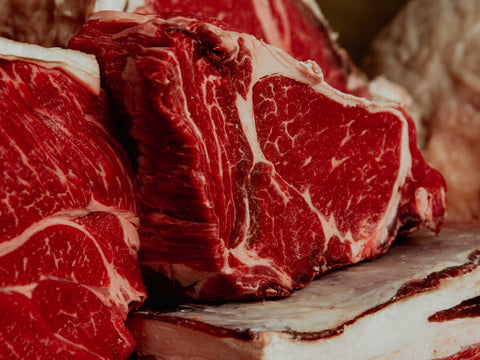You've probably seen dry-aged beef on the menu at your local butchers or favourite steak house, but what exactly is it and is the higher cost justified? We're here to settle the beef when it comes to dry-aged meat and explain how we dry-age, why we dry-age and what's in it for you!
Here’s what you NEED to know:
- Dry ageing uses airborne bacteria present all around us, meaning that it’s a super safe practice using the good old fashioned air that we breathe in every day!
- The dark crust on the outside of the beef carcass (as long as created in precise, dry conditions) is completely safe to eat and made by enzymatic build up…..minced down it has a wonderful flavour and is a bit of a secret ingredient!
- The reason it is not so widespread is that it isn’t commercially viable….vacuum packing ageless products makes far more money as you are literally selling blood and moisture that has not left the muscle. It’s also why commercial meat has no flavour!
Read on for more!
The Dry-Ageing Process
Whether you’re a meat mastermind or a beef beginner, you’ve probably realised that the crucial part of the dry-ageing process is the ‘dry’ part! This means removing moisture from the air and the meat to let the dry-ageing do its magic.
Dry-ageing beef can be achieved by hanging meat in a temperature and humidity-controlled environment from anywhere between 4 weeks to
many years! Our gold standard is in between the 35 to 60 day mark but on some parts of the carcass this can and may be tailored to a shorter or longer length of time.
Here’s a breakdown, pardon the pun, of what happens to the meat in this time:
- The cold temperature (between 0-3 degrees) and lack of humidity (50 - 85%) preserve the meat to enable ‘controlled decomposition’ – doesn’t sound appetising but that’s what’s happening!
- Airborne bacteria activate enzymes in the meat which breakdown connective tissues and muscle fibres, tenderising the meat
- Water evaporates from the beef (something you don’t get with wet-ageing) and this moisture loss results in a reduced weight of meat but a more concentrated flavour – you end up buying all meat and no waste liquid!
- Oxidation and evaporation create a protective crust around the exposed surface of the meat, under which enzymes and proteins work to mature the flavour
Think of dry-aged beef as the carnivorous equivalent of a fine wine or mature cheese – the yield isn’t as high, it costs a bit more but the taste and experience are incomparable to lower quality counterparts!
The Dry-Aged Difference
Taste – Removing moisture from meat condenses its natural flavour, for a beefier taste with a
deeper and richer flavour profile. The meaty process of getting our dry-aged beef just right is worth the effort from the very first forkful - there's no miss-steaking the superior taste of a dry-aged cut of beef!
Texture – Dry-aged beef is as tender as can be, giving a mouth-wateringly soft texture that's incredibly moreish. This tempting texture is all thanks to the enzymatic activity encouraged by dry-ageing, which breaks down muscle fibres and connective tissue to make them softer and easier to chew. This ease of eating paired with a superior flavour is a winning combination for any carnivore!
Appearance – Remember Rembradnt, our painter from earlier? Well we think he was right in recognising dry-aged beef as a piece of art. In fact, some say the dry-ageing process is more of an art than a science! You can expect your dry-aged beef to be darker in colour thanks to the maturation process, with lovely marbling all of the way through and a more robust shape.
Aroma – Meat mavericks and carnivore connoisseurs liken the aroma of a fine dry-aged beef to a rich and buttery popcorn, a nutty and earthy woodland, a sumptuous and decedent blue cheese and even freshly foraged truffles! We’re all for the theatrics of their descriptors but in our words dry-aged beef has the same appeal on the nostrils as a freshly carved roast joint – simply inviting and drool-inducing!
Thomas Joseph Dry-Aged Beef
Our beef is dry aged in-house using our purpose-built cold store with a dehumidifying system to filter, purify and dry the air to our specific requirements – we remove over a 1 and a half litres of water every day from our cold stores
-
We also use Himalayan salt blocks in the atmosphere to further dry and purify the air using their antibacterial properties. We feel the salt adds a depth of flavour to our meat along with seasoning it for a long as it takes!
-
We’re experts in tailoring the ageing process to specific parts of the carcass, so that each cut can reach its full potential
-
We love to hear from you – if you have a specific dry-ageing request, drop us a line and we’ll see if we can make your dry-aged dreams come true! (Visitors MORE than welcome)









Leave a comment